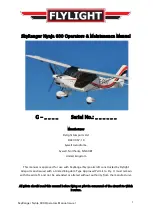
2
USING THIS INSTRUCTION MANUAL
Before you begin assembling your
E
En
nd
du
urra
an
ncce
e 4
40
00
0
ARF
,
take some time to read through this entire instruction book.
It is designed to take you step-by-step through the process
and to give you added information on motor and radio
selection and set-up, balancing your aircraft, and flying
your model. The time you spend will speed the assembly
process and help you avoid problems.
PREPARING FOR ASSEMBLY
You will need a work area of approximately 24 x 48" which has
been covered to protect it from adhesive, as well as cuts and
other damage. Many people cover their work area with a
sheet of dry wall (sheet rock) and/or waxed paper t o pre-
vent CA Glue and Epoxy from ruining the work surface.
CONSTRUCTION TIPS
IMPORTANT: ALWAYS READ A FEW STEPS AHEAD.
This will alert you to coming instructions and will help you
plan accordingly.
Using the Parts Identification section, familiarize yourself
with the various items included in your kit box.
Do not hesitate to ask questions. Your local hobby dealer
and area flyers will most likely be happy to help, as they
want you to have a successful flying experience.
You may also receive technical assistance from Carl
Goldberg Products, Ltd. via e-mail (questions@carlgoldberg-
products.com) or by telephone 1-678-450-0085.
ADHESIVES & GLUING TECHNIQUES
CA adhesives are specially formulated to firmly glue the
plywood, hardwood, and balsa used in your model and to
withstand the vibration and stresses of high performance
flight. However, there are times, such as when you are
installing the stabilizer and fin on the fuselage and want
more set-up time for careful alignment and positioning,
then you should use epoxy. Occasionally, you also will
want to use thin CA, which "wicks" into the surrounding
areas. Aliphatic resin glue or similar water-based glues can
also be used, but they will add to the assembly time
because they dry so much more slowly than CA glue.
Remember, when ever using any CA, you must be careful
to read instructions thoroughly, as you will have only sec-
onds for positioning of parts. Be sure to trial fit parts
together before gluing. Also, never use watery THIN type
CA glue for gluing plywood and hardwood parts. Thin CA's
do not adequately bond these areas.
CAUTION
Some people may experience an allergic reaction when
exposed to fumes from CA glue or epoxy. As with paints,
thinners, and solvents, it is always important to use glues
only where there is adequate ventilation to carry fumes
away. A fan is recommended. Also, special care must be
taken when using CA, as it will bond skin as well as other
surfaces. Before using any CA, carefully read all label pre-
cautions. When using CA, protective eye-wear and care in
keeping the glue away from the face is highly recommend-
ed. If CA does happen to get into the eye, hold lid open
and flush with water only. Seek immediate medical atten-
tion.
COVERING
The
E
En
nd
du
urra
an
ncce
e 4
40
00
0
ARF is covered in a premium polyester
film chosen by many of the world's top flyers for its beauty,
toughness, and ease of application and repair. It is not
uncommon for ARF's to develop a few wrinkles in transit.
If this is true of your model, the situation is easily correct-
ed. Before you begin putting the pieces together, run
around the edge of the seams first then over the surface of
each section with an iron (either specially designed for air-
plane use or the more cumbersome household iron).
Apply the heat (set at about 350° F), following along with a
soft cloth and pressing down on the covering as you go
around. This will more firmly set the covering adhesive into
the wood and keep your aircraft covering tight and smooth
in the future. Once you have ironed the seams stay away
from them with the heat or the covering will slide when you
try to shrink the middle. If this happens the wrinkles will not
come out of the covering.
ITEMS NEEDED TO COMPLETE THIS AIRCRAFT
1 RADIO GUIDANCE SYSTEM (3 CHANNEL
MINIMUM REQUIRED WITH 3 SERVOS)
2 FUTABA 3108 SERVOS (AILERONS)
1 FUTABA 3101 SERVO (ELEVATOR)
1 MICRO RECEIVER (GWS)
2 6” AILERON SERVO EXTENSION WIRE
1 ELECTRONIC SPEED CONTROL (20 AMP
FOR LI-PO BATTERIES)
1 2 OR 3 CELL 1500 MAH LI-PO BATTERY
1 CA ACCELERATOR
1 1 OZ. BOTTLE CA MEDIUM GLUE
1 1/2 OZ. BOTTLE CA THIN GLUE
1 5 MINUET EPOXY
1 1/4” FOAM RUBBER
1 DOUBLE SIDED SERVO TAPE
1 ELECTRICAL TAPE
1 120 GRIT SAND PAPER
TOOLS AND SUPPLIES FOR ASSEMBLY
MODELING OR UTILITY KNIFE
WORK SURFACE (24" X48")
SMALL STANDARD & PHILLIPS SCREW-
DRIVERS
MASKING TAPE
NEEDLE NOSE PLIERS
24” RULER
FLEXIBLE STRAIGHT-EDGE
SOFT PENCIL
A FEW STRAIGHT OR "T" PINS
WIRE CUTTER (DYKES)
OPTIONAL HEAT GUN/COVERING IRON
HOT GLUE GUN




























